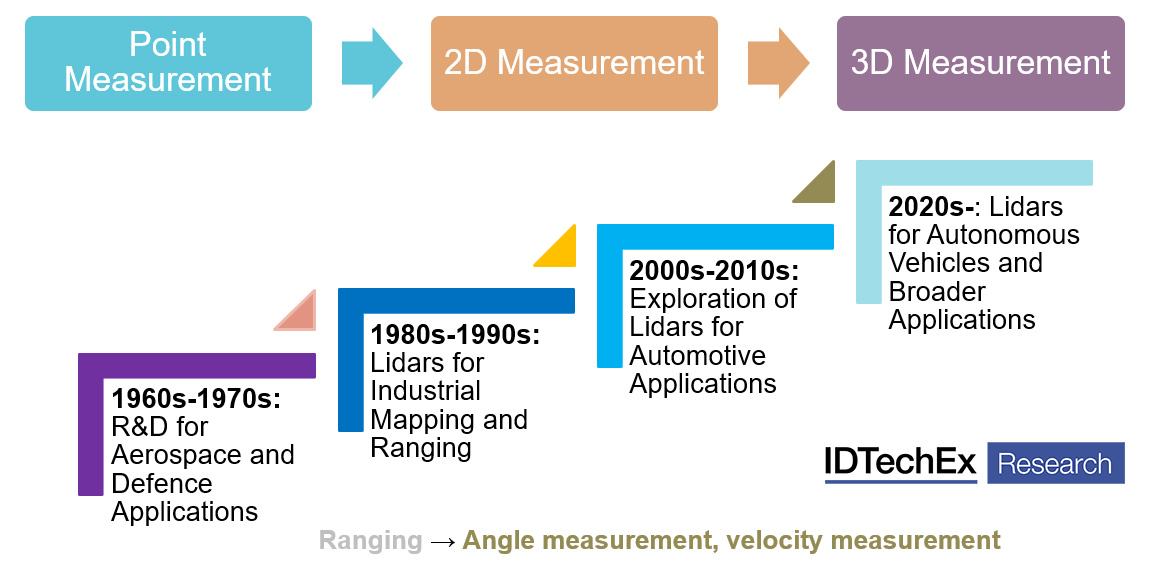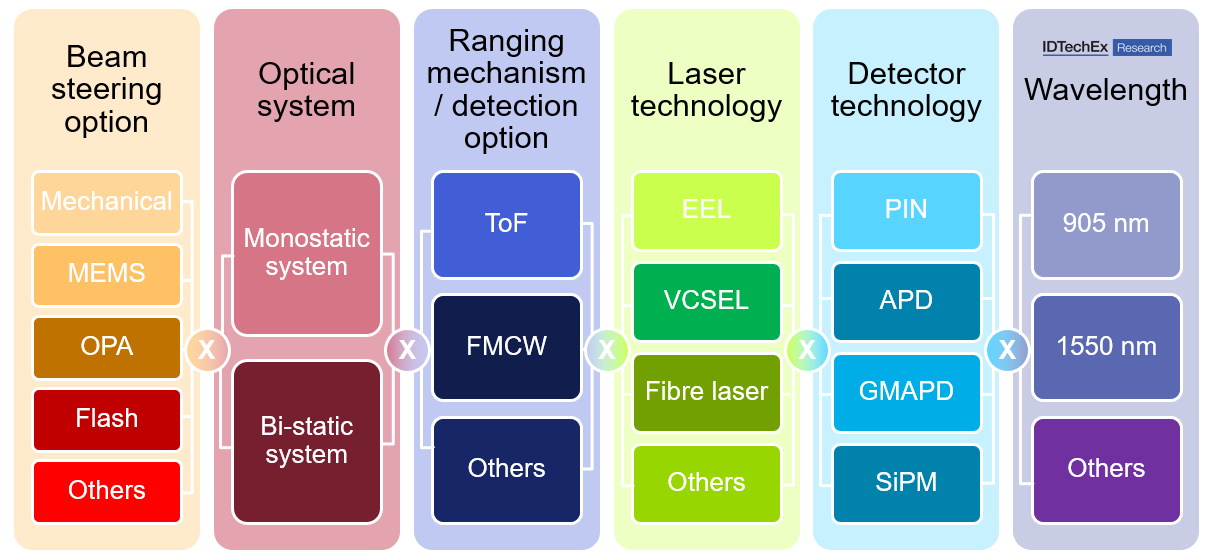| Light detection and ranging, or lidar, has decades of history since the invention of the laser, and it has already been adopted in applications such as mapping, surveying, military, archaeology, agriculture, geology, etc. With the innovation of lidar beam steering technologies, continuous lidar cost reduction, as well as the progress of Advanced Driving Assistance System (ADAS) and Autonomous vehicles (AV), lidars are embracing their potential $8.4 billion-dollar market by 2033. This is enabled by automotive applications, which can be further widely expanded to other areas such as robotics, industrial, smart cities, and mapping. The IDTechEx report “Lidar 2023-2033: Technologies, Players, Markets & Forecasts” provides research on lidar technology, business, market, and players.
Lidar technologies already have a history of decades of development
Lidar has a long history, and its development path has experienced four stages, as shown in the illustration below. Lidar was developed not long after the invention of the laser around the 1960s. Its ranging function was developed for aerospace and defense purposes initially. Later lidars could also be used to measure angles and velocity. Commercial and industrial lidars rose in the 1980s, and the 1990s benefited from the development of diode systems. Single line scanning system enables lidars to be used in other applications. In addition, GPS with the accuracy to centimeter level promoted the combination of lidars and positioning systems. These areas of progress have allowed lidars to be deployed in industrial and early-stage autonomous vehicle projects. It wasn’t until the 2000s that lidars started to be applied in commercial automotive applications. Since the commercial production of the first lidar in 2017, an increasing number of players have focused on automotive applications, especially autonomous vehicles. From 2020 onwards, with the autonomy levels moving towards L3, the lidar industry has also welcomed its speedy progression. Lidars have received huge investment and are moving towards chips and arrays with better performance.
|
 |
|
Lidar development path. Source: IDTechEx
|
|
Competitive technology landscape
Unlike other sensors such as cameras, radars or ultrasonic systems, lidars have relatively immature technology, higher price, unestablished supply chain, and an ever-changing market landscape. The rapidly evolving lidar technologies and markets leave many uncertain questions to answer. The technology landscape is cluttered with numerous options for every component in a lidar system, as shown in the figure below. The combinations of different ranging measurement processes, laser types, beam steering mechanisms, photodetector choices, wavelength options, and optical path possibilities make a massive number of possible lidar technologies and corresponding products. However, not all combinations are equally easy to realize. For instance, FMCW usually work with 1550nm wavelength, VCSEL may perform better with Flash lidar beam steering than EEL, MEMS have more difficulty combining with FMCW, etc.
Understanding relevant lidar technologies can help players to realize a commercial product with acceptable performance, pass the automotive grade and potentially lead to a cheaper manufacturing cost. Choosing the wrong technology combination, however, can result in the opposite. “Lidar 2023-2033: Technologies, Players, Markets & Forecasts” explores how innovations in lidar technology affect the growth of lidar market segments. IDTechEx uses its expertise in physics, optics, engineering, electronics, and beyond to analyze different technologies and explain novel technical concepts to a non-specialist audience.
|
 |
|
Possible lidar technology combinations. Source: IDTechEx
|
|
Rapidly evolving business landscape
The lidar market landscape is also evolving rapidly. A few companies went public via SPAC merger, some ceased trading, while more established partnerships with tier-1 and OEMs in various areas. In the meantime, lidar companies are also experiencing difficulties such as insolvency, bankruptcy, etc. The rapid cost reduction trend not only makes lidars potentially possible to be adopted in autonomous vehicle use scenarios but also helps them to be deployed in a wider range of applications. However, the current lidar adoption may not be mainly driven by performance.
|
|
A selection of partnerships between automotive OEMs and Lidar tier-2 players. Source: IDTechEx
|
|
Following a period of dedicated research by expert analysts, IDTechEx published a report which offers unique insights into the global 3D lidar technology landscape and corresponding market. The report contains a comprehensive analysis of 95 players developing 3D lidar for the ADAS and autonomous vehicles market, which includes a detailed assessment of technology innovations and market dynamics. While the market analysis and forecasts focus on the automotive industry, the technology analysis and company profiles also cover lidar for industrial automation, robotics, smart city, security, and mapping. Importantly, the report presents an unbiased analysis of primary data gathered via primary interviews with key players.
IDTechEx has focused on players who position themselves as automotive Tier 2 suppliers, with coverage of component suppliers and automotive OEMs. Market forecasts are based on extensive primary and secondary data analysis, combined with careful consideration of market drivers, restraints, and key player activities. The technology adoption roadmaps for six types of lidar in four types of level 3+ autonomous vehicles are evaluated to provide a balanced outlook on market opportunities. The lidar for automotive market is expected to grow to $8.4billion by 2023, according to the IDTechEx report “Lidar 2023-2033: Technologies, Players, Markets & Forecasts”. |
|